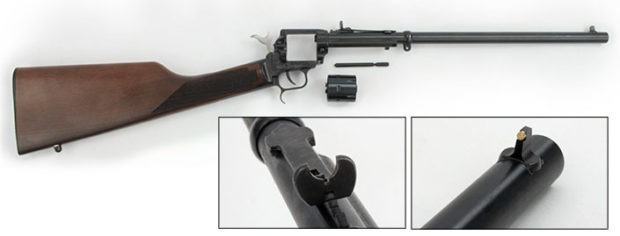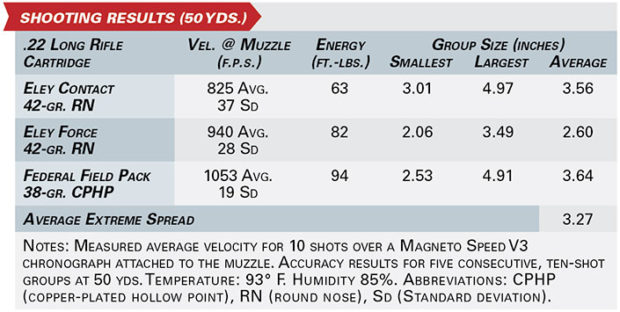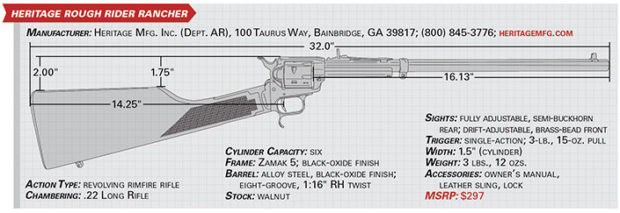By American Rifleman Staff
Heritage Mfg. is best known for its Rough Rider series of revolvers, low-cost models within the reach of virtually any shooter’s budget, and while these guns serve the needs of the pistolero, the company also wanted to offer something for those shooters looking for a fun-to-shoot shoulder-fired platform. So, in 2020, Heritage introduced the .22 Long Rifle-chambered Rancher, an unorthodox carbine version of a Rough Rider revolver—with a buttstock and a 16″ barrel—that continues the line’s reputation for affordability.
As with many of the more traditional hand-held members of its flagship rimfire line, Heritage’s Rancher is a single-action six-shooter with an alloy steel barrel and a Zamak 5 alloy frame. A black-oxide finish has been applied to both components for added resistance to wear and corrosion. The rifle’s checkered walnut stock has a length of pull of 14.25″, bringing the total length of the gun to 32″, and it weighs just 3 lbs., 12 ozs. empty.
Loading of the carbine is accomplished via a gate on the right side of the frame. To free the cylinder, the carbine’s hammer must be brought to its half-cock position, as only then can the cylinder be rotated to individually fill each chamber. Unloading the Rancher follows the same process, the ejector rod being used to push out fired cases. While chambered in .22 Long Rifle, the rifle’s cylinder can also accept .22 Short and .22 Long cartridges, and an aftermarket .22 WMR cylinder compatible with the Rancher is available but not included.

–
While the Rancher may indeed be a carbine, it is still a revolver at heart, and, as such, users need to be very aware of the placement of their support hand while firing it—positioning the off hand in front of the cylinder to support the weight of the gun could lead to serious injury. Instead, a spur is machined into the bottom of the trigger guard to provide a surface that can be gripped by the middle finger of the shooting hand, with the support hand then wrapping around it in the same manner as when firing a semi-automatic pistol. Further steadying can be accomplished through the use of an included leather sling that easily installs via sling studs located on the toe of the stock and a band on the barrel.

The Rough Rider Rancher is built with a traditional half-cock safety that locks the trigger while providing a bit of drop protection. In addition, there is also a left-side frame-mounted thumb safety that blocks the firing pin should you wish to carry the gun loaded with its hammer back. Checkering added to the hammer spur aids in handling while also adding a touch of flair to the firearm. The carbine makes use of a fully adjustable, semi-buckhorn rear sight and a brass bead front sight.
We started our range session with some function firing at 25 yds. to get a feel for the Rancher’s ergonomics. At just 32″ long and less than 4 lbs., it was not only exceptionally easy to maneuver, but it also didn’t exhibit even the slightest sign of muzzle heaviness. We found that proper use of the trigger guard spur put the shooter in a perfect position to brace both elbows against the chest while shooting, providing surprising stability even when standing.
For formal accuracy testing, we elected to use the above prescribed grip with our hands resting on a solid wooden rest—as using a bipod would have potentially interfered with barrel harmonics and using a sandbag would have likely resulted in it being ripped to shreds by the gases escaping through the cylinder gap. From 50 yds., we tested the remainder of the Federal Field Pack ammunition used during function firing alongside two match-grade offerings from Eley. Accuracy was more than acceptable for a rimfire firearm that is intended for casual plinking, most likely at short range. Extraction was effortless with most ammunition, however, breaking free the coated Eley Force cases required a slight tap of the ejector rod.

Although we found the Heritage Rough Rider Rancher to be a little strange to look at and even stranger to hold, we thoroughly enjoyed the experience of shooting it. Between its impeccable balance and crisp 3-lb., 15-oz. single-action trigger pull, knocking tin cans off of a fence post was both a piece of cake and highly enjoyable. All in all, despite its unconventional appearance, the Rancher would make an interesting addition to any firearm collection, and at an MSRP of less than $300, there’s no reason not to try something new.



